Navigation
Wildlife Preservation in Southeast Nova Scotia
The efforts of the Clean Annapolis River Project lead to preservation of the Annapolis River and its watershed in Nova Scotia, Canada, and its designation as a UNESCO Biosphere Reserve.
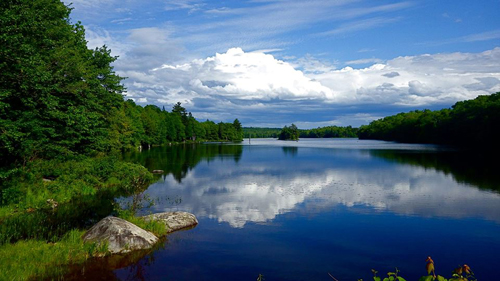 Grand Lake, Annapolis County, Nova Scotia.: Photograph by Katie McLean for the Clean Annapolis River Project
Grand Lake, Annapolis County, Nova Scotia.: Photograph by Katie McLean for the Clean Annapolis River Project
Les Smith wrote the following brief history of the Annapolis River for the Horizon International Solutions Site based on his experience as a significant member of the team who worked to preserve the Annapolis River and its watershed and helped found the Clean Annapolis River Project (CARP). Smith is an interpreter with Nova Scotia Power at the Annapolis Tidal Generating Station.
The CARP, a charitable, community-based, non-governmental organization incorporated in 1990, works “with communities and organizations to promote awareness about, and to foster the conservation, restoration and sustainable use of the marine and freshwater ecosystems of the Annapolis River Watershed.”
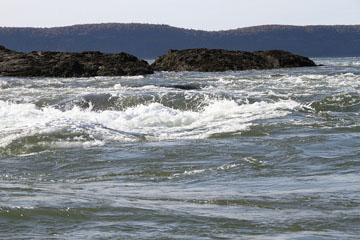 The amazing Churning water at Black Rock on the Bay of Fundy – this spring tide reached 45 feet: and featured currents of 5 metros per second. Photograph by David Dodge, Green Energy Futures, Fundy Ocean Research Centre & Bay of FundyThe Annapolis River is an unusual place, as it is a semi tidal estuary, affected by the only tidal power generating plant in North America.
The amazing Churning water at Black Rock on the Bay of Fundy – this spring tide reached 45 feet: and featured currents of 5 metros per second. Photograph by David Dodge, Green Energy Futures, Fundy Ocean Research Centre & Bay of FundyThe Annapolis River is an unusual place, as it is a semi tidal estuary, affected by the only tidal power generating plant in North America.
The complete story is more complicated than that.
To understand the Annapolis River and the changes it has seen, you have to go back to the mid 17th century.
When the French colonists returned to the Bay of Fundy, to the region they called LaCadia, they recognized the conditions here were similar to the north coast of the Brittany Peninsula and brought farmers with dyke building technology.
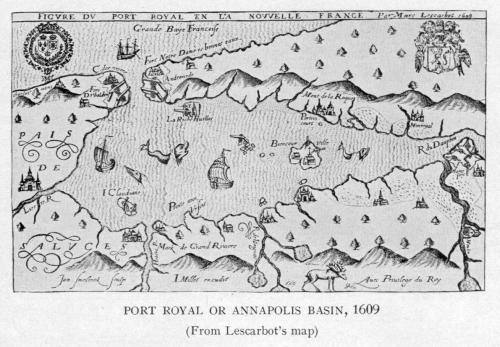 Champlain's map of 1609 showing the river's French name of Rivière du Dauphin.: Port Royal, Nova Scotia - circa 1609 - Project Gutenberg etext 20110. Image courtesy of Wikipedia.
Champlain's map of 1609 showing the river's French name of Rivière du Dauphin.: Port Royal, Nova Scotia - circa 1609 - Project Gutenberg etext 20110. Image courtesy of Wikipedia.
The Rivier Dauphan, as it was called at that time, was dyked all the way to the head of the tide, at Paradise, some 25 miles by river from the site of the settlement of Port Royal.
 Bald Eagle, Annapolis Royal, Nova Scotia.: Photograph by Katie McLean for the Clean Annapolis River ProjectThose dykes kept the high tides off the marshes and the Acadian farmers soon had the best farmland around. Even after the Deportation of these French-speaking people, generations of farmers maintained the dyke system until the Second World War.
Bald Eagle, Annapolis Royal, Nova Scotia.: Photograph by Katie McLean for the Clean Annapolis River ProjectThose dykes kept the high tides off the marshes and the Acadian farmers soon had the best farmland around. Even after the Deportation of these French-speaking people, generations of farmers maintained the dyke system until the Second World War.
In the 1950s, the thinking of the time led to an old bridge which connected Annapolis Royal with Granville Ferry to be replaced with a causeway.
The Department of Agriculture operated the gates in the causeway to regulate the water level of the river and keep it some 8 feet below the high tide mark in the Annapolis Basin. In this way the old dykes were no longer needed.
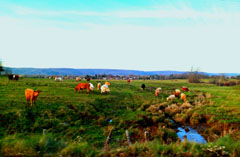 Cow pasture, Kings County, Nova Scotia.: Photograph by Angela Hughes for the Clean Annapolis River ProjectThe changes to the Annapolis River were drastic.
Cow pasture, Kings County, Nova Scotia.: Photograph by Angela Hughes for the Clean Annapolis River ProjectThe changes to the Annapolis River were drastic.
First the river was changed from a salt-water estuary with an average tide of 25' to a fresh-water lake with no tidal effect at all.
In addition to losing the clams, crabs, flounder, etc. the salt grasses which had grown on the sloping riverbanks were also lost.
This loss, coupled with a static "lake" level, lead to wave generated erosion in the lake between Annapolis Royal and Bridgetown.
In addition, in the '60s the state of sewage treatment in the western Annapolis Valley was typical in that raw sewage was discharged from many locations into the river and the Department of Agriculture would lower the river several feet each spring to expedite building of fences into the river so livestock which accessed the river for drinking water would not stray from their fields.
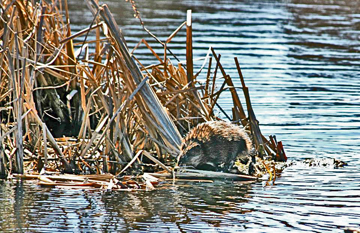 Muskrat at Annapolis basin marsh, Annapolis Royal, Nova Scotia.: Photograph by Katie McLean for the Clean Annapolis River ProjectA Department of Agriculture technician advised me in the early '80s that some summers the gates at Annapolis Royal might not be opened for as much as 6 weeks as the meager flow of the Annapolis River was easily handled through a fish passage in the causeway and by evaporation.
Muskrat at Annapolis basin marsh, Annapolis Royal, Nova Scotia.: Photograph by Katie McLean for the Clean Annapolis River ProjectA Department of Agriculture technician advised me in the early '80s that some summers the gates at Annapolis Royal might not be opened for as much as 6 weeks as the meager flow of the Annapolis River was easily handled through a fish passage in the causeway and by evaporation.
One might speculate on the condition of the river.
In 1980 the Causeway at Annapolis Royal was selected as the site of the Annapolis Tidal Power Test Station.
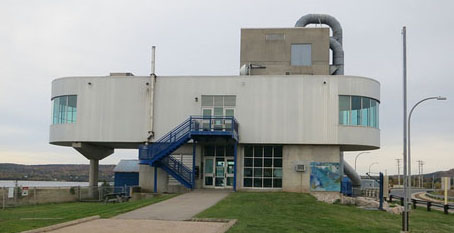 The Annapolis Tidal Generating Station has a capacity of 20 megawatts and is the only one of its kind in North America.: The environmental factors involved with the power station are still being considered. Photo David Dodge, Green Energy Futures Annapolis Tidal Generating Station, Nova Scotia
The Annapolis Tidal Generating Station has a capacity of 20 megawatts and is the only one of its kind in North America.: The environmental factors involved with the power station are still being considered. Photo David Dodge, Green Energy Futures Annapolis Tidal Generating Station, Nova Scotia
Installing a tidal turbine at the location meant that the river level would now fluctuate by just over two feet with each tide, as some 800,000 tons of seawater would be sluiced into the head pond then discharged through the turbine.
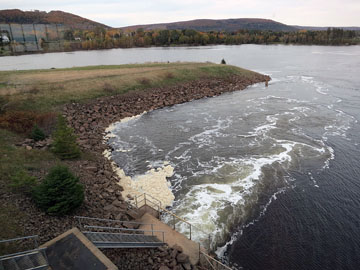 Fish passage at the Annapolis Tidal Generating Station: Photograph by David Dodge, Green Energy Futures
Fish passage at the Annapolis Tidal Generating Station: Photograph by David Dodge, Green Energy Futures
It is interesting to note some landowners were alarmed by the development and were sure their land would be ruined by the return of the salt water to the estuary.
This proved not to be the case.
 Nesting Osprey seen from the Annapolis Royal Generating Station: Photograph by Janine M. H. Selendy
Nesting Osprey seen from the Annapolis Royal Generating Station: Photograph by Janine M. H. Selendy
The Clean Annapolis River Project (CARP) was founded in 1990 to assess the condition of the river.
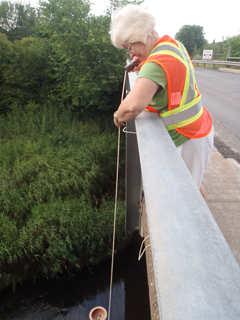 River Guardian Vicky Parker, sampling on the Annapolis River.: Photograph courtesy of Clean Annapolis River ProjectTeams of volunteers called River Guardians began testing the river bi-weekly for temperature, turbidity, fecal coliform and suspended solids.
River Guardian Vicky Parker, sampling on the Annapolis River.: Photograph courtesy of Clean Annapolis River ProjectTeams of volunteers called River Guardians began testing the river bi-weekly for temperature, turbidity, fecal coliform and suspended solids.
Over the years, armed with solid research, CARP managed to work with towns, farmers and householders along the river and its tributaries to introduce up to date sewage treatment facilities, restrict livestock access to the watercourses and eliminate non-functioning septic systems.
 Yellow-rumped warbler.: Photograph by Katie McLean for the Clean Annapolis River Project
Yellow-rumped warbler.: Photograph by Katie McLean for the Clean Annapolis River Project 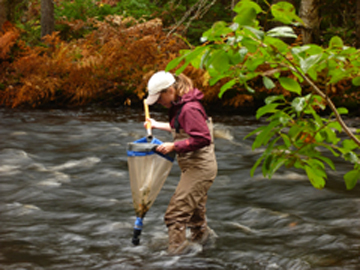 Lindsey Freeman conducting benthic invertebrate sampling. Part of the CARP Sub-watershed planning project: Photograph by Clean Annapolis River Project
Lindsey Freeman conducting benthic invertebrate sampling. Part of the CARP Sub-watershed planning project: Photograph by Clean Annapolis River Project
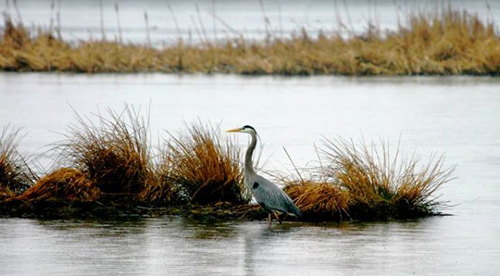 Great blue heron on the Annapolis Basin Marsh, Annapolis Royal, Nova Scotia.: Photograph by Katie McLean for the Clean Annapolis River Project
Great blue heron on the Annapolis Basin Marsh, Annapolis Royal, Nova Scotia.: Photograph by Katie McLean for the Clean Annapolis River Project
The Annapolis River is quite a different place today.
As the CARP website states, “While the group has received considerable recognition for its efforts, the real measure of success is the creation of environmental improvements in the Annapolis watershed.”
CARP attributes its success to partnerships including:
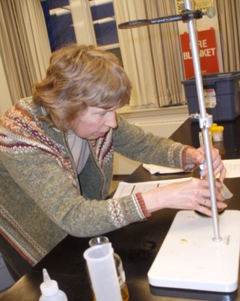 River Guardian conducting a titration.: Photograph courtesy of Clean Annapolis River ProjectNearly twenty years of volunteer based water quality monitoring
River Guardian conducting a titration.: Photograph courtesy of Clean Annapolis River ProjectNearly twenty years of volunteer based water quality monitoring
Participation of 14 farms in GHG reduction projects
- Salt marshes protected through private stewardship agreements and outright donation
- Numerous local businesses actively engaged in pollution prevention
- Homeowners participating in sewage management and water and energy conservation programs
- Joint projects with 14 Wing Greenwood to affect environmental enhancement adjacent to the military base to protect sections of the river
Over 20 farm stewardship agreements signed
 500.jpg) Sunset of Kejimkujik Lake, Kejimkujik National Park.: Photograph by Katie McLean for the Clean Annapolis River Project
Sunset of Kejimkujik Lake, Kejimkujik National Park.: Photograph by Katie McLean for the Clean Annapolis River Project
In 2001, The Annapolis River watershed area was declared part of a biosphere reserve, the UNESCO Southwest Nova Biosphere Reserve.
UNESCO writes: “Southwest Nova represents the natural region of southwestern Nova Scotia. This encompasses the five counties: Queens, Shelburne, Yarmouth, Digby and Annapolis.
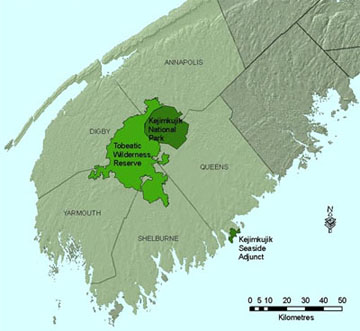 UNESCO Southwest Nova Biosphere Reserve
UNESCO Southwest Nova Biosphere Reserve
 Canada Geese at the Annapolis Basin Marsh, Annapolis Royal, Nova Scotia.: Photograph by Katie McLean for the Clean Annapolis River Project
Canada Geese at the Annapolis Basin Marsh, Annapolis Royal, Nova Scotia.: Photograph by Katie McLean for the Clean Annapolis River Project
"The biosphere reserve comprises major landscapes of the province, which exist in a near-pristine condition with intact ecosystem structure, processes and functions.
"Located in the boreal needleleaf forest biogeographical region, it includes rolling plains, river plains, glacial plains, hills, drumlins and coastal cliffs.
 Tree swallows, Annapolis Basin Marsh, Annapolis Royal, Nova Scotia.: Photograph by Katie McLean
Tree swallows, Annapolis Basin Marsh, Annapolis Royal, Nova Scotia.: Photograph by Katie McLean
"As a result of its unique southerly position in the Maritimes, the region contains significant disjunctive populations of Atlantic coastal Plain plant species, Blandings turtle (Emydoidea blandingi), ribbon snake (Thamnophis sauritus) and southern flying squirrel (Glaucomys volans).”
Resources:
The Clean Annapolis River Project < http://www.annapolisriver.ca> and http://www.annapolisriver.ca/aboutcarp.php
Search
Latest articles
Agriculture
- World Water Week: Healthy ecosystems essential to human health: from coronavirus to malnutrition Online session Wednesday 24 August 17:00-18:20
- World Water Week: Healthy ecosystems essential to human health: from coronavirus to malnutrition Online session Wednesday 24 August 17:00-18:20
Air Pollution
- "Water and Sanitation-Related Diseases and the Changing Environment: Challenges, Interventions, and Preventive Measures" Volume 2 Is Now Available
- Global Innovation Exchange Co-Created by Horizon International, USAID, Bill and Melinda Gates Foundation and Others
Biodiversity
- It is time for international mobilization against climate change
- World Water Week: Healthy ecosystems essential to human health: from coronavirus to malnutrition Online session Wednesday 24 August 17:00-18:20
Desertification
- World Water Week: Healthy ecosystems essential to human health: from coronavirus to malnutrition Online session Wednesday 24 August 17:00-18:20
- UN Food Systems Summit Receives Over 1,200 Ideas to Help Meet Sustainable Development Goals
Endangered Species
- Mangrove Action Project Collaborates to Restore and Preserve Mangrove Ecosystems
- Coral Research in Palau offers a “Glimmer of Hope”
Energy
- Global Innovation Exchange Co-Created by Horizon International, USAID, Bill and Melinda Gates Foundation and Others
- Wildlife Preservation in Southeast Nova Scotia
Exhibits
- Global Innovation Exchange Co-Created by Horizon International, USAID, Bill and Melinda Gates Foundation and Others
- Coral Reefs
Forests
- NASA Satellites Reveal Major Shifts in Global Freshwater Updated June 2020
- Global Innovation Exchange Co-Created by Horizon International, USAID, Bill and Melinda Gates Foundation and Others
Global Climate Change
- It is time for international mobilization against climate change
- It is time for international mobilization against climate change
Global Health
- World Water Week: Healthy ecosystems essential to human health: from coronavirus to malnutrition Online session Wednesday 24 August 17:00-18:20
- More than 400 schoolgirls, family and teachers rescued from Afghanistan by small coalition
Industry
- "Water and Sanitation-Related Diseases and the Changing Environment: Challenges, Interventions, and Preventive Measures" Volume 2 Is Now Available
- Global Innovation Exchange Co-Created by Horizon International, USAID, Bill and Melinda Gates Foundation and Others
Natural Disaster Relief
- STOP ATTACKS ON HEALTH CARE IN UKRAINE
- Global Innovation Exchange Co-Created by Horizon International, USAID, Bill and Melinda Gates Foundation and Others
News and Special Reports
- World Water Week: Healthy ecosystems essential to human health: from coronavirus to malnutrition Online session Wednesday 24 August 17:00-18:20
- STOP ATTACKS ON HEALTH CARE IN UKRAINE
Oceans, Coral Reefs
- World Water Week: Healthy ecosystems essential to human health: from coronavirus to malnutrition Online session Wednesday 24 August 17:00-18:20
- Mangrove Action Project Collaborates to Restore and Preserve Mangrove Ecosystems
Pollution
- Zakaria Ouedraogo of Burkina Faso Produces Film “Nzoue Fiyen: Water Not Drinkable”
- "Water and Sanitation-Related Diseases and the Changing Environment: Challenges, Interventions, and Preventive Measures" Volume 2 Is Now Available
Population
- "Water and Sanitation-Related Diseases and the Changing Environment: Challenges, Interventions, and Preventive Measures" Volume 2 Is Now Available
- "Water and Sanitation-Related Diseases and the Changing Environment: Challenges, Interventions, and Preventive Measures" Volume 2 Is Now Available
Public Health
- Honouring the visionary behind India’s sanitation revolution
- Honouring the visionary behind India’s sanitation revolution
Rivers
- World Water Week: Healthy ecosystems essential to human health: from coronavirus to malnutrition Online session Wednesday 24 August 17:00-18:20
- Mangrove Action Project Collaborates to Restore and Preserve Mangrove Ecosystems
Sanitation
- Honouring the visionary behind India’s sanitation revolution
- Honouring the visionary behind India’s sanitation revolution
Toxic Chemicals
- "Water and Sanitation-Related Diseases and the Changing Environment: Challenges, Interventions, and Preventive Measures" Volume 2 Is Now Available
- Actions to Prevent Polluted Drinking Water in the United States
Transportation
- "Water and Sanitation-Related Diseases and the Changing Environment: Challenges, Interventions, and Preventive Measures" Volume 2 Is Now Available
- Urbanization Provides Opportunities for Transition to a Green Economy, Says New Report
Waste Management
- Honouring the visionary behind India’s sanitation revolution
- Honouring the visionary behind India’s sanitation revolution
Water
- Honouring the visionary behind India’s sanitation revolution
- Honouring the visionary behind India’s sanitation revolution
Water and Sanitation
- Honouring the visionary behind India’s sanitation revolution
- Honouring the visionary behind India’s sanitation revolution

